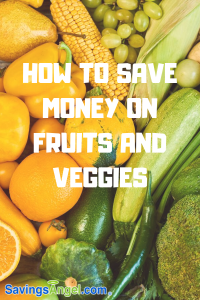How to Save Money on Fruits and Veggies

Harvesting has already begun on a wide variety of fruits and veggies and will continue over the upcoming weeks. It’s time to savor the abundance of healthy produce – without spending a bundle. Here are 7 ideas on how to save money on fruits and veggies this fall.
Here are 7 ways on how you can save money on fruits and vegetables.
- Watch your quantities. Perhaps the #1 rule in saving money is to not buy too much at one time. If the produce you choose is sold by the pound or by the piece, and you are eyeing several tasty varieties, only get a small amount of each for the week. Fruits and veggies can be a lot more filling than they look. You may find yourself unable to consume it all fast enough. If you can’t – then freeze some of it. You can freeze nearly all types of produce.
- Hit the farmer’s markets and vegetable stands. Often these locations can offer foods less expensively than the grocery stores. It all depends on the type of produce and the quality. But when it comes to freshness, you can’t beat true, locally grown and harvested. You do want to scrutinize what is offered, however. Not all stands at the market are stocking only locally grown produce. Don’t just assume everything is “farm fresh”. When in doubt, ask. It’s not uncommon to find items that were actually purchased at the local grocery store and then marked up.
- Consider frozen and canned. Many varieties of fruits, and especially veggies, freeze and can very well. They can even be tastier and healthier than fresh bought at the store. This is because fresh produce is rarely allowed to fully ripen before picking. Growers have to harvest it very early, with the hope (expectation) that it will fully ripen while on the way to the store and to your home. That transit time is built into when the produce is picked so that it is not already overripe or going bad before you buy it. On the flip side of that, frozen and canned varieties are processed so quickly that growers can wait to pick them until peak ripeness. This process maximizes vitamins and nutrients. On top of taste and health, frozen and canned can be less expensive than the fresh versions when you take advantage of sales and coupons. Just be sure to choose healthy options, not those loaded with a lot of extra sugar, syrups or preservatives.
- Decide if you really need organic. Although the price gap has shrunk some over the years, organic still typically costs more. The process to grow organic (without the use of pesticides) means that produce cost more to grow. And that additional cost is passed on to the consumer. So when should you spring for organic and when can you get regularly grown produce? As a rule of thumb, produce with thick, inedible skins – that cover and protect the fruit or vegetables – generally contain the smallest amount of pesticides. If you’re not going to eat the skin anyway, you may not need to pay for organic. If you are, you may want to consider it. For a list of safer non-organic foods, and foods to avoid if not organic, check out the EWG’s 2019 Shopper’s Guide, containing the “Clean 15” and “Dirty Dozen”.
- Immediately remove and eat or toss any bruised produce. The old saying, “One bad apple can spoil the whole bunch” is not just a metaphor. It’s rooted in truth. Open packages up and look through them carefully as soon as you get home from the store. Pat dry any produce that has gotten wet, especially berries. Then store properly for the type of fruit or veggie. For example, did you know that storing apples and potatoes together can be a good idea? But storing apples with other items is not?
- Give wilting and overripe produce new life. Many recipes are delicious with fruits and veggies that might otherwise just be thrown away. Think salsas, chutneys, soups, stews, breads and cookies. Anything where the texture is supposed to be softer. Find ways to use produce instead of throwing it away to save money. In fact, if you’re diligent and make those types of recipes often, consider buying “seconds” at farmer’s markets or “marked down for quick sale” selections at the grocery store. You’ll save a lot of money.
- Grow your own produce indoors year-round. You’ll need a few things to get started but you absolutely can grow some things in pots indoors. Especially smaller plants like peppers and herbs. With a little effort, you’ll get some of your produce very inexpensively once you get started. Plus, you’ll be able to pick and eat it at peak ripeness and flavor. Plant Natural Research Center has a great guide on how to have a tiny farm and harvest indoors. They also list the types of plants that do well.


